
Laurence Stephen Lowry was an English artist. His drawings and paintings mainly depict Pendlebury, Greater Manchester as well as Salford and its vicinity.

Salford, also known as the City of Salford, is a metropolitan borough with city status in Greater Manchester, England. The borough is named after its main settlement, Salford, but covers a larger area which includes the towns of Eccles, Swinton, Walkden and Pendlebury. The borough had a population of 278,064 in 2022, and is administered from the Salford Civic Centre in Swinton.

Salford Museum and Art Gallery, in Peel Park, Salford, Greater Manchester, opened to the public in November 1850 as the Royal Museum and Public Library. The gallery and museum are devoted to the history of Salford and Victorian art and architecture.

Pendlebury is a town in the City of Salford, Greater Manchester, England. The population at the 2011 Census was 13,069. It lies 4 miles (6 km) north-west of Manchester, 3 miles (5 km) north-west of Salford and 6 miles (10 km) south-east of Bolton.
Arthur McEvoy Delaney was an English painter whose scenes of Manchester life were influenced by those of L. S. Lowry, gaining some popularity since his death.

The Lowry is a theatre and gallery complex at Salford Quays, Salford, Greater Manchester, England. It is named after the early 20th-century painter L. S. Lowry, known for his paintings of industrial scenes in North West England. The complex opened on 28 April 2000 and was officially opened on 12 October 2000 by Queen Elizabeth II.

Burnden is a district in the town of Bolton in Greater Manchester, England. It is located about 1 mile (2 km) southeast of Bolton town centre.
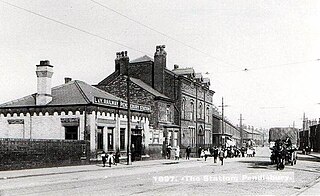
Pendlebury railway station was a station serving the town of Pendlebury in the City of Salford, Greater Manchester, England. It was closed in 1960 by British Railways.

Harold Francis Riley, DL was an English artist. He sold his first painting to the Salford Museum and Art Gallery when he was 11.
Liam Spencer is a British artist.

Peel Park is a public urban park in Salford, Greater Manchester, England, located on the flood plain of the River Irwell below Salford Crescent and adjacent to the University of Salford. It was the first of three public parks to be opened on 22 August 1846, for the people of Manchester and Salford, paid for by public subscription. The park was the main public venue for the 1851 royal visit of Queen Victoria to Manchester and Salford and has been the subject of a number of paintings by the Salford artist, L.S. Lowry.

"Matchstalk Men and Matchstalk Cats and Dogs (Lowry's Song)" is a folk song by English duo Brian and Michael. It was released as their first single in late 1977 on Pye Records, and is from their 1978 debut album, The Matchstalk Men. The song reached number one on the UK Singles Chart for 3 weeks in April 1978. As the song is their only major hit, the duo remain as one-hit wonders in the UK, although one more single titled "Mama" briefly made the UK charts at No. 93 in 1983.
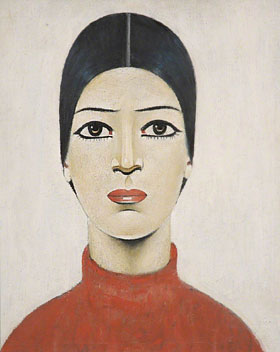
Portrait of Ann (1957) is a painting by British artist L. S. Lowry (1887–1976). Opinion remains divided as to the identity of the subject, who appears in many of Lowry's works, and her significance for the artist.
Shirley Baker was a British photographer, best known for her street photography and street portraits in working class areas of Greater Manchester. She worked as a freelance writer and photographer on various magazines, books and newspapers, and as a lecturer on photography. Most of her photography was made for her personal interest but she undertook occasional commissions.
Theodore Major was an English artist who was considered a great individualist of British Art
Geoffrey Key is a British painter and sculptor. A number of public art collections have examples of his work.
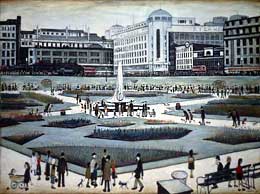
Piccadilly Gardens is a 1954 oil painting by the English artist L. S. Lowry. It depicts Piccadilly Gardens, a large garden square in Manchester city centre, north-west England. The painting hangs in the Manchester Art Gallery on nearby Mosley Street.
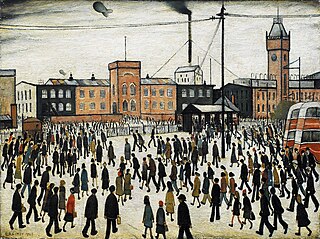
Going to Work is a 1943 oil painting by the English artist L. S. Lowry.
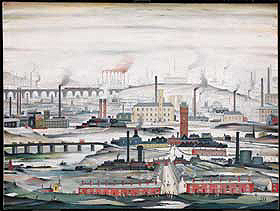
Industrial Landscape is the title given to each of a series of oil paintings by the English artist L. S. Lowry, painted over a number of years between 1934 and 1955.
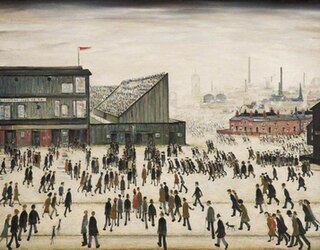
Going to the Match is the title of a number of paintings by British painter L. S. Lowry, depicting crowds of spectators walking towards a sports ground. Lowry's best known Going to the Match painting is his 1953 painting of football fans heading towards Burnden Park, the then home of Bolton Wanderers Football Club. Two earlier works of this title also exist; a 1928 painting depicting fans outside a rugby ground, and a 1946 painting of a crowd of sports fans.


















